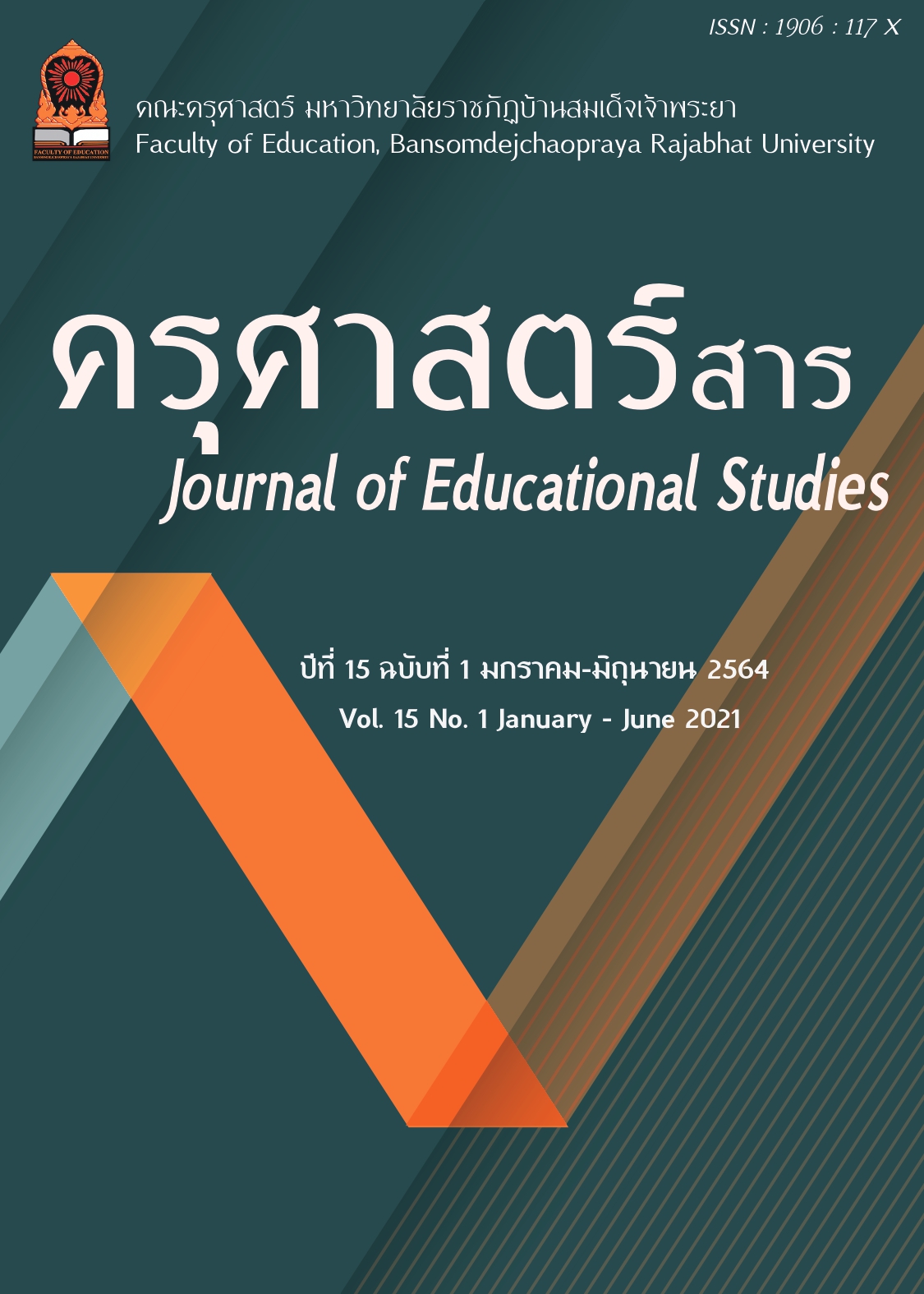วารสาร
การเรียนรู้แบบผสมผสาน Blended Learning ในวิถี New Normal
กุลธิดา ทุ่งคาใน
มหาวิทยาลัยราชภัฏบ้านสมเด็จเจ้าพระยา
บทคัดย่อ
ในศตวรรษที่ 21 เทคโนโลยีสารสนเทศและการสื่อสารมีการพัฒนาไปอย่างรวดเร็ว และมีบทบาทสำคัญในการพัฒนาทางด้านการศึกษา ผู้เรียนสามารถเข้าถึงเนื้อหาบทเรียนได้ทุกเวลาทุกสถานที่และสามารถมีปฏิสัมพันธ์กับเพื่อนร่วมชั้นเรียนและผู้สอนได้ โดยใช้คอมพิวเตอร์และเครือข่ายอินเทอร์เน็ตเป็นสื่อกลางการเรียนแบบผสมผสาน (Blended Learning) เป็นการเรียนรู้ที่ผสมผสานวิธีการเรียนแบบเผชิญหน้ากับการเรียนรู้ผ่านระบบสื่อคอมพิวเตอร์ออนไลน์เข้าด้วยกัน องค์ประกอบการเรียนแบบผสมผสาน (Blended Learning) สามารถแบ่งออกเป็นได้ 2 องค์ประกอบหลัก คือ องค์ประกอบออฟไลน์และองค์ประกอบออนไลน์ การจัดการเรียนการสอนแบบผสมผสาน (Blended Learning) ให้ประสบผลสำเร็จนักออกแบบการเรียนการสอน ต้องคำนึงถึงจุดประสงค์ของการเรียนที่กำหนดไว้ ระยะเวลาในการเรียนรวมถึงความแตกต่างของรูปแบบการเรียนรูและการคิดของผู้เรียน เพื่อใช้เป็นข้อมูลพื้นฐานในการออกแบบกิจกรรมการเรียนการสอน บทบาทของผู้เรียนและผู้สอนในการเรียนแบบผสมผสาน (Blended Learning) ผู้สอนจะต้องเป็นผู้กำหนดวิธีการสอนแบบต่าง ๆ โดยมีบทบาทเป็นผู้ฝึก (Coach) กระตุ้นให้ผู้เรียนเกิดการเรียนรู้ด้วยตนเอง ส่วนผู้เรียนมีบทบาทสำคัญคือเป็นผู้ศึกษาหาความรู้ตามสถานการณ์ที่เกิดขึ้น ประโยชน์ของการเรียนการสอนแบบผสมผสานทำให้การเรียนการสอนมีความสะดวกรวดเร็วในการเข้าถึงบทเรียนและยังช่วยพัฒนาผู้เรียนให้เกิดทักษะทางเทคโนโลยีสารสนเทศ ในการสืบค้นข้อมูลทางอินเทอร์เน็ต จากความสำคัญนี้สรุปได้ว่าการเรียนรู้แบบผสมผสาน (Blended Learning) เป็นรูปแบบการเรียนอีกทางเลือกหนึ่งที่เหมาะสมกับสภาพการณ์ของประเทศไทยที่จะนำมาใช้ในการจัดการเรียนรู้ในปัจจุบันได้เป็นอย่างดี
Abstract
In the 21st century, information and communication technology has developed rapidly. And plays an important role in the development of education Learners can access lesson content at any time, anywhere and can Interact with classmates and teachers. By using computers and the Internet as a medium Blended Learning is a learning approach that combines face-to-face learning with learning. Through a computer media system online together. Blended Learning can be divided into two main components: Offline elements and online elements Blended Learning is a successful teaching and learning designer. Must take into account the intended learning objectives The length of study includes the different learning styles and thinking of the learners. To be used as a basis for designing teaching and learning activities. Role of learners and teachers in Blended Learning: Teachers have to define different teaching methods by playing a coach role to encourage learners to learn by themselves. The learners play an important role, namely, being the educator of the situation in which they arise. The benefits of blended teaching make teaching and learning easier and faster to access lessons and also help develop learners to acquire information technology skills. To search the Internet , From this importance it can be concluded that blended learning is another form of learning that is suitable for the situation of Thailand that will be used in the present learning management.
คำสำคัญ
การเรียนรู้แบบผสมผสาน Blended Learning, New Normal
Keywords
Blended Learning, New Normal
เอกสารอ้างอิง
ใจทิพย์ เอื้อรัตนพงศ์. (2550). E-Instructional Design วิธีวิทยาการออกแบบการเรียนการสอนอิเล็กทรอนิกส์. กรุงเทพฯ: จุฬาลงกรณ์มหาวิทยาลัย.
ปณิตา วรรณพิรุณ. (2554). “การเรียนรู้แบบผสมผสานจากแนวคิดสู่การปฏิบัติ”. วารสารการอาชีวะและเทคนิคศึกษา. 1(2). 43-49.
สมใจ จันทร์เต็ม. (2553). การพัฒนารูปแบบการเรียนการสอนแบบผสมผสาน รายวิชาคอมพิวเตอร์เบื้องต้นสำหรับนักศึกษาระดับปริญญาตรี (ปริญญานิพนธ์ปริญญาดุษฎีบัณฑิต). กรุงเทพฯ: มหาวิทยาลัยเทคโนโลยีพระจอมเกล้าพระนครเหนือ.
สมบูรณ์ กลางมณี. (2554). การพัฒนาหลักสูตรฝึกอบรมครูภาษาอังกฤษระดับมัธยมศึกษาโดยใช้แนวคิดเชิงประสบการณ์ (สารนิพนธ์ปริญญามหาบัณฑิต). อุบลราชธานี : มหาวิทยาลัยการจัดการและเทคโนโลยีอีสเทิร์น.
สุพรรณี แสงชาติ. (2552). ผลของการเรียนแบบผสมผสานโดยใช้แนวคิดการเรียนรู้แบบผสมผสานและแนวคิดการเรียนรู้แบบค้นพบด้วยวิธีอุปนัยและนิรนัย (วิทยานิพนธ์ปริญญามหาบัณฑิต). กรุงเทพฯ: มหาวิทยาลัยกรุงเทพธนบุรี.
อินทิรา รอบรู้. (2553). การพัฒนารูปแบบการเรียนการสอนแบบผสมผสานเพื่อเพิ่มประสิทธิภาพการแสวงหาความรู้ด้วยตนเอง. (วิทยานิพนธ์ปรัชญาดุษฎีบัณฑิต) . กรุงเทพฯ : มหาวิทยาลัยเทคโนโลยีพระจอมเกล้าพระนครเหนือ.
Allen. I. E. and Seaman. J. (2007). Growing by Degrees: Online education in the United States, The Sloan Consortium. [Online] Available from: http://www.sloan-c.org/publications/survey/pdf/growing_by_degrees.pdf. [2020, October 6]
_______. (2010) . Learning on Demand: Online Education in the United States, 2009. USA : Sloan Consortium.
Bernath , R. ( 2012 ). Effectives Approaches to Blended Learning for Independent Schools. [Online]. Available from: http://www.testden.com/partner/blended%20learn.html. [2020, October 6]
Bersin. J. (2004). The blended learning book: Best practices, proven methodologies, and lessons learned. San Francisco : Pfeiffer.
Bonk. C. J. and Graham C.R. (2006). The handbook of blended learning: global perspectives, local designs. San Francisco : Pfeiffer.
Carman, J. M. (2006). Blended Learning Design: Five Key Ingredients. [Online]. Available from: http://www.agilantlearning.com/ pdf/Blended%20Learning%20Design.pdf. [2020, October 6]
Graham. C.R. (2012). Introduction to Blended Learning. [Online]. Available from: http://www.media.wiley.com/product_data/except/86/C.pdf. [2020, October 10]
Graham. C.R. and Dziuban. C. (2008). “Blended Learning Environments” in Spector ,M.J. et.al ( Editors ) Handbook of Research on Educational Communications and Technology. (3rd ed.) New York : Lawrence Erlbaum Associates.
Graham. C.R. ; Allen. S. and Ure. E. (2003). Blended Learning Environments : A Review of the Research Literature. Unpublished Manuscript , Provo , UT.
Horn. B.M. and Staker. H. ( 2011 ) The Rise of K-12 Blended Learning. Unpublished Paper. : Innosight Institute.
Jared M. Carman (2002). Blended Learning Design : Five Key Ingredients. KnowledgeNet. [Online]. Available from: http://blended2010.pbworks.com/f/Carman.pdf. [2020, October 20]
limitlesseducation.net (2020). Blended Learning ระบบการเรียนรู้ในยุค 4.0. [Online]. Available from: https://www.limitlesseducation.net/blended-learning/blended-learning. [2020, October 11]
Sharpe. R. ; Benfield. G. ; Roberts. G. and Francis. R. (2006). The Undergraduate Experience of Blended Learning : A Review of UK Literature and Practice. [Online]. Available from: http://www.heacademic.ac.uk/assets/documents/pdf. [2020, October 5]
Singh. H. (2005). Building effective blended learning programs. [Online]. Available from: http://www.bookstoread.com/framework/blendedlearning.pdf [2020, October 5]
Suh. Sookyung. (2005). The Effect of Using Guided Questions and Collaborative Groups for Complex Problem Solving on Performance and Attitude in a Web-Enhanced Learning Environment. Ph.D. Dissertation, College Of Education, the Florida State University.
Thorne, K. (2003). Blended learning: how to integrate online and traditional learning. London: Kogan Page.
Uwes, A.C. (2008). Dimensi Model Blended Learning. [Online]. Available from: http: // fakultasluarkampus.net/ 2008/11/dimensi-model-blended-learning [2020, October 7]
